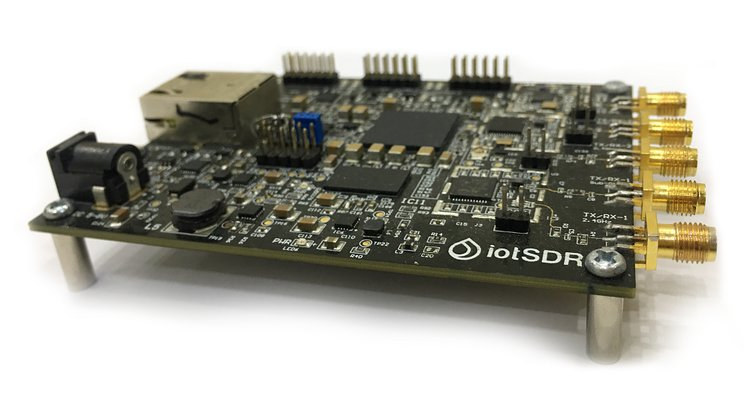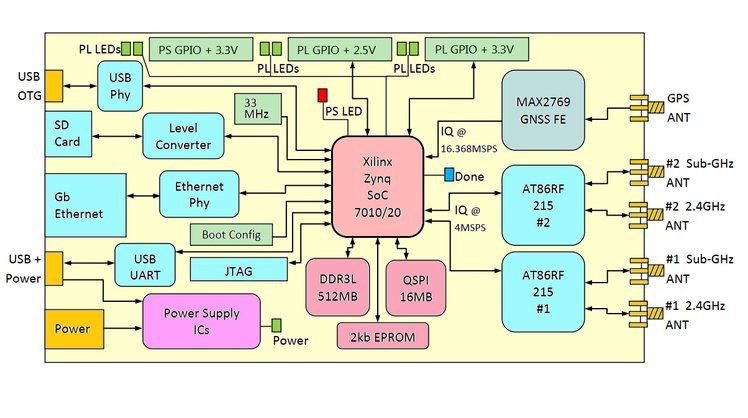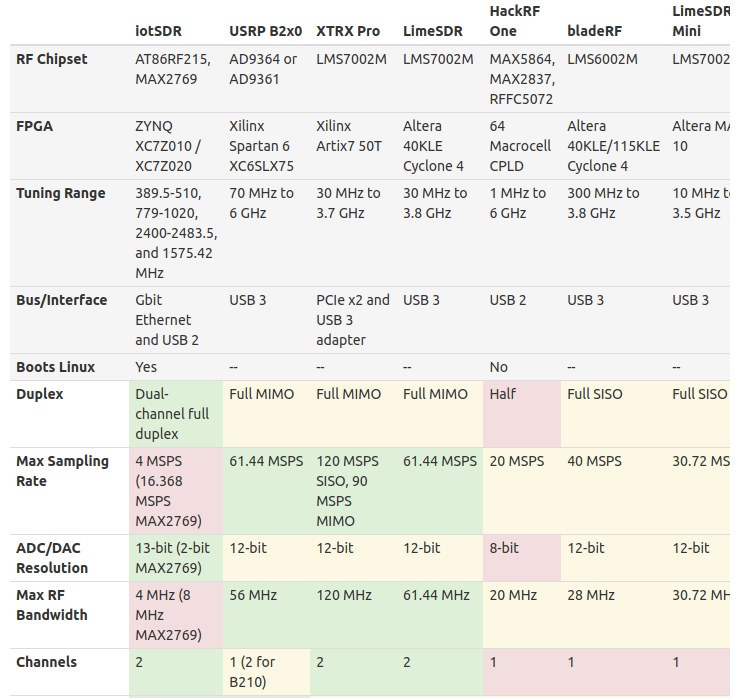Xilinx Zynq-7010/-7020 powered iotSDR board by EmbedINN enables the development of IoT gateways with support for LoRa, SigFox, WeightLess, Bluetooth, BLE, 802.15.4, ZigBee, as well as custom IoT protocols.
The board also supports GPS, Galileo, Beidou, and GLONASS navigation systems thanks to a Maxim Integrated MAX2769 GNSS chip.

iotSDR key hardware features and specifications:
- SoC (one or the other)
- Xilinx Zynq-Z7010 (XC7Z010-1CLG400C) dual-core Arm Cortex-A9 processor with 256 kb on-chip memory, FPGA fabric with 28,000 logic cells, 17,600 LUTs, 2.1 Mb block RAM, 80 DSP slices
- Xilinx Zynq-Z7020 (XC7Z020-1CLG400C) dual-core ARM Cortex-A9 processor with 256 kb on-chip memory, FPGA fabric with 85,000 logic cells, 53,200 LUTs, 4.9 Mb block RAM, 220 DSP slices
- System Memory – 512 MB DDR3
- Storage
- 128 Mbit QSPI flash memory for firmware
- Microchip AT24MAC602 SPI EEPROM for RF transceiver MCU firmware and data
- Radios
- “IoT” Radios
- RF Transceivers – 2x Microchip/Atmel AT86RF215
- European band – 863-870 MHz / 870-876 MHz / 915-921 MHz
- Chinese band – 470-510 MHz / 779-787 MHz
- North American band – 902-928 MHz
- Korean band – 917-923.5 MHz
- Japanese band – 920-928 MHz
- Worldwide ISM band – 2400-2483.5 MHz
- Output power – 14 dBm
- Receiver sensitivity – -123 dBm
- Single clock source for both RF frontends
- 2x SMA RF connector for low-frequency IoT band
- 2x SMA RF connector for 2.4 GHz band
- RF Transceivers – 2x Microchip/Atmel AT86RF215
- GNSS
- Maxim MAX2769B supporting GPS, GLONASS, Galileo, and Beidou
- Clock for GNSS receiver
- 1x SMA connector for GNSS receiver
- “IoT” Radios
- Networking – Gigabit Ethernet port
- USB
- USB 2.0 High Speed via Microchip USB3310
- USB 2.0 Full Speed via Silicon Labs CP2104
- Expansion
- 2x 8-bit PL (Programmable Logic) interfaces
- 1x 8-bit PS (Programmable Subsystems) interface
- Debugging – FPGA JTAG connector for external JTAG programmer/debugger
- Power Supply – DC power barrel
- Dimensions – 101.6 x 76.2 mm


The main difference between iotSDR and other SDR boards like LimeSDR or HackRF One is that the former focuses specifically on ISM bands (sub-GHz and 2.4 GHz) design for IoT applications while other boards usually offer a much larger tuning band. iotSDR is also the only board to run Linux from the list of boards in the comparison above.
The company promises the board will eventually be fully open-source with the FPGA HDL code and hardware & software design documents pushed to a GitHub repository before shipping to backers.
iotSDR board has just launched on Crowd Supply for $399 with Zynq-7010 FPGA Arm SoC, and $599 with Zynq-7020. This does not include accessories like antennas and cables that you’d either have to purchase separately or for $99 on the crowdfunding page. Shipping is free to the US and $10 to the rest of the world with the company planning to start shipping at the end of January 2021.

Jean-Luc started CNX Software in 2010 as a part-time endeavor, before quitting his job as a software engineering manager, and starting to write daily news, and reviews full time later in 2011.
Support CNX Software! Donate via cryptocurrencies, become a Patron on Patreon, or purchase goods on Amazon or Aliexpress





That AT86RF215 part looks neat, having so much flexibility across sub-1GHz and 2.4GHz. It’s available as a QFN48 in 3 different models: AT86RF215 (sub-1GHz and 2.4GHz, with baseband controllers), AT86RF215IQ (sub-1GHz and 2.5GHz, no baseband controllers), and AT86RF215M (sub-1GHz only with baseband controller), all with the same pinout (though obviously not all the pins are functional on all models), and all with direct I/Q access via LVDS. I didn’t know there were radio chips available in both “smart” and “dumb” versions like that. The I/Q radio-only version would be fun to play with and is not too expensive (~$4.80 in… Read more »
Was thinking about the same once I realised it’s really an SDR and not just a nrf24l01 style of thing.
Would love to see a simple, cheap usb key shaped version, else I guess a Pluto SDR would be more interesting
iotSDR features Gb Ethernet and dual Transceivers chips. It gives an option for 7020 as well.
It also supports Jupyter notebook and google RPC, besides GNU Radio support and python.
It is probably the only project on Zynq, that has implemented the google RPC for remote configuration and data streaming.